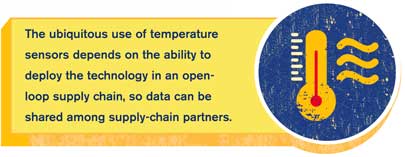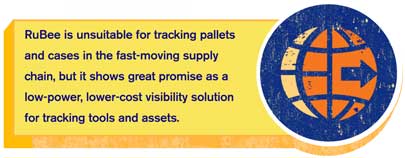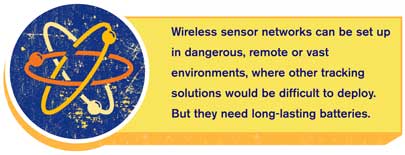Dec 01, 2008ournal's Watch List, intended to help you assess the future of radio frequency identification. This week, we'll focus on the technologies to watch; we profiled the companies and organizations last week, and the people the week before. Overall, we think there are many exciting developments on the horizon, so stay tuned.
By Elizabeth Wasserman
Dec. 1, 2008—Radio frequency identification is at a crossroads. During the past six years, it's gone from an obscure technology used by a handful of companies to a technology that is more widely understood and is being adopted in a broad range of business, government and consumer applications. The advancement of RFID can be attributed to the forward-thinking people who recognized its potential, the companies and organizations that boldly tested and implemented it, and the technology developments that made it smarter, as well as easier and less costly to deploy.
But RFID has not reached the level of adoption many envisioned, particularly in the global supply chain. As businesses plan for 2009 and 2010, and consider whether to invest in RFID or other technologies, the looming question is: Will RFID adoption accelerate across industries, or will it forever remain a niche technology delivering value in only a few applications?
That question can't be answered today; it will only be answered over time. To help you see the writing on the wall more clearly, RFID Journal's editors surveyed the RFID landscape to identify the people, the companies and organizations, and the technological innovations that are most likely to influence adoption, either positively or negatively. On the following pages, you'll find our Watch List to help you assess the future of RFID. Overall, we think there are many exciting developments on the horizon, so stay tuned.
Beam-Steerable Phased-Array Antennas
Developed by the U.S. military and NASA, beam-steerable phased-array antenna technology is now being employed for commercial use by startups Mojix and RF Controls. Both antenna systems use a focused, low-power, electronically steerable beam of RF energy to sweep a large area. When paired with EPC RFID-compliant readers, these "smart antennas" offer capabilities not possible with current passive ultrahigh-frequency systems. Receivers are more sensitive and can read tags from longer distances and locate tags in 3-D space. The ability of these systems to cover a larger area could lower the cost of deployment for companies and organizations, and the ability to read tags in three dimensions opens up new applications.
While hailed as a revolutionary, next-generation passive UHF solution, the technology still needs time to mature for commercial uses, says Michael Liard, research director of RFID and contactless technology at ABI Research. Three major consumer packaged goods manufacturers have successfully tested Mojix's STAR system: Kimberly-Clark in a manufacturing facility in Wisconsin, Kraft Foods in a warehouse in Germany, and Procter & Gamble in its distribution center in Massachusetts. But, Liard says, the technology needs to be vetted by a variety of companies to prove that it works in different environments and has a strong value proposition.
RFID tags with temperature sensors can monitor the condition of perishable products, such as chemicals, cosmetics, flowers, foods and pharmaceuticals, as well as parts used in manufacturing. In the cold chain, products must be maintained within a given temperature range—cold or hot—to prevent damage and spoilage and prolong shelf life. Unlike static temperature loggers, cold-chain sensors can provide real-time monitoring of conditions in warehouses, refrigerated trucks and freezer units, so temperature deficiencies can be corrected or noted.
Roche Diagnostics has partnered with logistics company DHL to use RFID in conjunction with sensor technology to track pharmaceuticals that need to be refrigerated at certain temperatures. And studies and pilots show that cold-chain sensors have the potential to dramatically improve the food supply chain, delivering benefits to both manufacturers and retailers, says Jean-Pierre Emond, co-director of the IFAS Center for Food Distribution and Retailing at the University of Florida.
But the ubiquitous use of temperature sensors depends on the ability to deploy the technology in an open-loop supply chain, so data can be shared among supply-chain partners. Currently, with the proprietary nature of cold-chain sensing systems, there is no standard format for sensor data, says Christopher Weirup, a senior manager at Accenture.
Cost is another factor. It may make more economic sense to employ cold-chain sensors in an industry such as pharmaceuticals, where products have a higher value per item, Weirup says. But, he adds, it is feasible that a sensor-equipped RFID tag could have an EPC number for the product, and technology companies are working to lower the cost of cold-chain sensors.
Interactive RFID Displays
RFID-enabled kiosks, mirrors and other types of displays present new opportunities for communication between consumers and retailers—without the help of salespeople. Such displays have built-in RFID interrogators that read RFID-tagged merchandise and show detailed information about the product or even a promotional video. The most common application is in the apparel industry, where some retailers have installed "magic mirrors" in dressing rooms. Shoppers can learn about the origin and care of a garment's fabric, find out if the item is available in a different color or size, and even get suggestions for related accessories.
Interactive RFID displays are fairly expensive—and items have to be RFID-tagged to trigger the interactivity—which is partly why they have been confined mostly to high-end retail stores. But they offer the opportunity to increase sales, while simultaneously addressing two pressing and costly issues: inventory control and out-of-stocks.
The Near Field Communication Forum was established in 2004, by Nokia, Philips and Sony, to develop standards for the short-range, high-frequency wireless technology and promote its use in consumer electronic devices for payment, ticketing and other communication applications. Today, the forum has 150 members worldwide—including handset hardware manufacturers, software developers, banks, credit card organizations and mobile telecommunications companies—all working together to foster NFC adoption, particularly in mobile phones.
An NFC RFID tag is integrated into a mobile phone's circuitry, where it can function as a passive tag or an interrogator, depending on the application. Most of the standards issues underpinning NFC have been worked out. Numerous trials in Asia, Europe and North America have shown that consumers like the convenience of using their NFC-enabled mobile phones to purchase fares for public transportation or pay for goods in sports arenas. And NFC technology doesn't raise privacy concerns, because the short-range transmission limits eavesdropping on RFID-enabled transactions.
ABI Research estimates that more than 20 percent of all mobile phones used in the United States will be NFC-enabled by 2012. But NFC needs to overcome a variety of barriers before it becomes a wildly popular mainstream consumer technology. "NFC is hamstrung by a lack of supporting infrastructure, technical standards, cooperation among value-chain participants and market misperceptions," says a March 2008 report from VDC Research Group. Most important, there is uncertainty about the NFC business model—whether telcos or credit card organizations will handle the financial transactions and collect fees. These issues may slow NFC handset adoption, while other smaller-scale applications, such as using NFC in airport passenger ticketing, might take off.
Printed-Electronics RFID Tags
This relatively new technology promises to lower the cost of conventional RFID tags by using standard printing processes to print integrated circuits (ICs) on paper, plastic and other materials, rather than the complicated method used to manufacture silicon chips. In October, Kovio announced that it had created a passive RFID inlay with a printed silicon IC. Other printed-electronics companies, such as OrganicID and PolyIC, are testing organic materials, rather than silicon inks, to print chips.
"This brings the cost down," says Raghu Das, CEO of research group IDTechEx, which recently published a report on printed electronics. "The most expensive part of the RFID tag right now is the silicon chip. This will enable the five-cent tag. This has a shot at the big time, going on everything."
But printed electronics is not a viable replacement for the silicon-based RFID chip—yet. Printed-electronics companies are focused on high-frequency tags, which don't have the performance of conventional HF tags. Still, Das says, these tags have a place in the market. For example, Kovio has been working with Cubic, a company that designs and manufactures automatic fare-collection systems, to develop a lower-cost transit card.
The bigger challenge for printed-electronics companies will be to create an ultrahigh-frequency tag that could be used in the open supply chain. That's because a silicon chip can be manufactured with millions of transistors, but only a few hundred or thousand can be printed on an IC. It limits the ability to incorporate all the features of standard EPC RFID chips, Das says.
Visible Assets developed the technology and drove its standards adoption by the Institute of Electrical and Electronics Engineers. The company named RuBee after the Rolling Stones' 1967 hit "Ruby Tuesday." It's an advanced form of active RFID whose tags function at a low frequency (132 kHz), which gives it different capabilities compared with RFID tags that operate at high (13.56-MHz) and ultrahigh (856- to 960-MHz) frequencies. Whereas HF and UHF RFID uses the radio portion of electromagnetic communication to transmit signals, RuBee tags use 99.9 percent magnetic waves and 0.01percent radio waves. This means RuBee has fewer performance problems than RFID in the presence of liquid and metals, or areas of high electromagnetic interference.
Due to RuBee's low frequency, its tags can't match the read rates of conventional RFID tags, making the technology unsuitable for tracking pallets and cases in the fast-moving supply chain. But RuBee shows great promise as a low-power, lower-cost visibility solution for tracking tools and assets. For instance, handgun manufacturer Sig Sauer recently employed the technology for its weapons inventory-management system. And because its tags have a large memory capacity and can be integrated with sensors, RuBee could be a viable solution for tracking product pedigrees in the health-care and pharmaceutical industries.
Sensor Networks
These wireless networks consist of groups of small devices called nodes, or motes, that have sensors to measure conditions such as humidity, light, temperature and vibrations; a battery; a radio transceiver for communication; and a microprocessor to store data. The nodes form mesh, or ad hoc, networks, exchanging data with any other nodes within their communication range, until the cumulative information is collected at a base station.
Wireless sensor networks can be set up in dangerous, remote or vast environments, where other tracking solutions would be difficult to deploy. For example, researchers are testing the technology to track wildfires and firefighters in burning buildings. The technology is already being used by BP to monitor corrosion of oil pipelines in Alaska, and by a nature preserve in Panama administered by the Smithsonian Tropical Research Institute to keep track of environmental changes.
Sensors need long-lasting batteries, and that can drive up the cost of a wireless network, particularly one that covers vast terrain, says IDTechEx's Das. Also holding back development of sensor network technology is a lack of standards, and only a few companies—including Gentag, Hewlett-Packard, IBM and Olsonet Communications—are developing or selling products in this area.
But an announcement in October by GE Global Research could advance the technology: GE scientists have developed a battery-free HF passive RFID tag with an antenna that is capable of functioning as multiple sensors, which could be used for monitoring air, food or water safety, and tracking the presence of chemical or biological contaminants. The company says a commercial device could be available in about two years.
Unlike conventional rigid batteries, thin-form batteries—either thin-film or printed—are lightweight and flexible, and can be made in any shape or size. Thin-film batteries are produced using standard semiconductor techniques and can operate at both high and low temperatures—Oak Ridge Micro-Energy says they have been tested at extremes from minus 20 degrees to 150 degrees Celsius (minus 4 to 302 degrees Fahrenheit). That means they can be soldered onto chips, and it makes them a good option for tags used to track items in heated or refrigerated environments.
But a report from NanoMarkets in March 2008 found that thin-film batteries are considerably more expensive than conventional batteries, which are produced in higher volumes. Other companies, such as Blue Spark Technologies, are making printed thin-form batteries, using cheaper printed-electronics methods. Enfucell says the printing process is environmentally friendly, and its battery "is disposable with household wastes."
This industry is still fairly nascent, but manufacturers such as Dell, Panasonic and Sony are already using thin-form batteries to power ultra-thin and ultra-lightweight consumer devices, from digital cameras and music players to computers, says Susan Eustis, president of WinterGreen Research. Other growth areas for thin-form batteries include electric bicycles and cars, and renewable energy sources, such as solar panels for homes. The driver is "energy density," Eustis says, because the thin-form batteries have from 60 to 6,000 times the ability of conventional batteries to store energy for later use.
Thin-form batteries also could be used to create active tags that are almost as thin as conventional passive RFID labels. If they can be produced cheaply enough, they could solve many problems associated with reading tags at the center of pallets of RF-unfriendly products.
Ultra-Wideband RFID
Ultra-wideband is a radio technology that uses very "narrow," or short-duration, pulses, operating across a frequency segment wider than that used by conventional active RFID tags. UWB real-time locating systems (RTLSes) use active tags to track personnel and assets, but in April, research-and-development firm Martec announced it was testing a UWB RFID system employing passive or semi-active tags, which could lower the cost of UWB systems.
Indoor precision-tracking is what comes to mind with UWB systems. Multispectral Solutions, Time Domain and Ubisense have employed the technology to locate tagged tools to within a few feet. Time Domain, Ubisense and other companies have also developed UWB RTLSes for hospitals. "A hospital may need to know that a doctor is on the floor and also that an IV pump is in the closet," says ABI's Liard.
UWB RFID systems can be used in proximity to other RF-generating technologies without causing interference. The question is whether UWB will supplant other tracking technologies, particularly in hospitals and facilities that already have Wi-Fi networks.
ZigBee is a communication standard for active 2.4 MHz, low-power wireless devices designed for sensor networks. The technology is simpler and cheaper than Wi-Fi, but it's also less powerful. For several years, ZigBee has struggled to find its place in the wireless network arena, but that's beginning to change.
When the U.S. electrical industry decided to replace old electricity meters with new, network-enabled devices that could monitor and even control energy consumption, ZigBee filled the bill.
Wi-Fi consumed too much power and was too expensive. Today, millions of dollars are being invested in ZigBee home-automation technology. ZigBee networks are also being put into place to control lighting and monitor HVAC systems. The technology has been deployed by a diverse range of organizations, such as the Walter Reed Army Medical Center to track assets and the Chicago Fire Department to locate firefighters.
The pairing of ZigBee and RFID is expected to increase adoption. "There are exponential benefits from combining sensing and locating on the same network, especially as networks increase to hundreds, even thousands, of nodes," says Mareca Hatler, director of research at ON World.
But for widespread acceptance, the price of ZigBee modules needs to drop from between $10 and $50 apiece to less than $5. The utility energy initiatives are helping drive down the price.
The 225-member ZigBee Alliance, which includes Honeywell, Mitsubishi Electric, Motorola, Samsung Electronics, STMicroelectronics and Texas Instruments, seeks to encourage open global standards to be developed for the technology. This is important for devices to be interoperable, Hatler says.
Additional Stories
• RFID Journal's Watch List: People to Watch
• RFID Journal's Watch List: Companies and Organizations to Watch
What do you think the future holds for RFID adoption—and who and what is on your watch list? We'd like to know. Share your thoughts and opinions by writing to us at
editor@rfidjournal.com.
Letter to the Editor:
I found your narrative of the top people, companies and technologies to watch in '09 a fascinating read, and we are thrilled that you are of the opinion that beam-steerable phased array antennas is an important, change-enabling RF technology that will encourage the expanded utilization of passive UHF RFID in the immediate future. We, of course, agree!
However, we take issue with the wording likening RF Controls' ITCS to Mojix's STAR: "Both antenna systems use a focused, low-power, electronically steerable beam of RF energy to sweep a large area." This is not true of Mojix's STAR, where, from their published information, STAR uses distributed eNodes to excite tags that come in relatively close proximity to an eNode antenna, operating in a rather conventional way, similar to a portal reader. Distributed eNodes are under the control of a centrally located master controller, which includes a high-performance receiver and associated phased array antenna; this is used only for receiving tag signals, and STAR achieves excitation of tags at a physically predetermined point of interest, such as a portal or marshalling area.
ITCS works in a distinctly different manner. ITCS employs bidirectional electronically steerable phased array antenna technology. In this way, within the area (or volume) covered by an ITCS installation, you can have completely arbitrary placement of tagged items within the volume covered, and ITCS is demonstrably capable of accurately locating those tags (tagged objects), in 3-D, without the need to ensure that distributed exciters are placed where tagged objects are expected to be located. This architecture and mode of operation is explained in information published on our Web site.
Succinctly, ITCS solves the business process problem of "Where's my stuff now?" without needing to predetermine where tagged objects need to be located in order to be energized and then remotely identified.
We strongly feel that there needs to be clarification of the differences between our approach and that which Mojix has created. We are in the process of creating a non-technical briefing paper for general consumption, which we expect to release in January.
Chris Hook
Executive VP, Business Development
RF Controls




